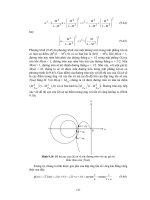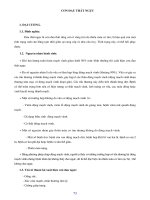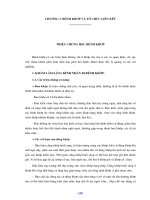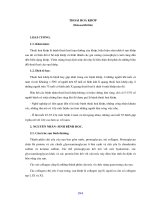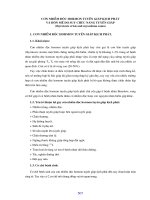GIÁO TRÌNH MARKETING NGHIÊN CỨU - PHẦN 13 ppsx
Bạn đang xem bản rút gọn của tài liệu. Xem và tải ngay bản đầy đủ của tài liệu tại đây (332.46 KB, 56 trang )
Determining the Size of
a Sample
Ch 13 2
Sample Accuracy
•
Sample accuracy: refers to how close
a random sample’s statistic is to the
true population’s value it represents
•
Important points:
–
Sample size is not related to
representativeness
–
Sample size is related to accuracy
Ch 13 3
Sample Size and Accuracy
•
Intuition: Which is more accurate: a
large probability sample or a small
probability sample?
•
The larger a probability sample is, the
more accurate it is (less sample
error).
Ch 13 4
A Picture Says 1,000 Words
±
Probability sample accuracy (error) can be calculated with a
simple formula, and expressed as a ± % number.
n 550 - 2000 = 1,450
4% - 2% = ±2%
Ch 13 5
How to Interpret Sample
Accuracy
•
From a report…
–
The sample is accurate ± 7% at
the 95% level of confidence…
•
From a news article
–
The accuracy of this survey is ±
7%…
Ch 13 6
How to Interpret Sample
Accuracy
•
Interpretation
–
Finding: 60% are aware of our brand
–
So… between 53% (60%-7%) and
67% (60%+7%) of the entire
population is aware of our brand
Ch 13 7
Sample Size Axioms
•
To properly understand how to
determine sample size, it helps to
understand the following axioms…
Ch 13 8
Sample Size Axioms
•
The only perfectly accurate sample is a
census.
•
A probability sample will always have
some inaccuracy (sample error).
•
The larger a probability sample is, the
more accurate it is (less sample error).
•
Probability sample accuracy (error) can
be calculated with a simple formula,
and expressed as a +- % number.
Ch 13 9
Sample Size Axioms
•
You can take any finding in the
survey, replicate the survey with the
same probability sample size, and
you will be “very likely” to find the
same finding within the +- range of
the original finding.
•
In almost all cases, the accuracy
(sample error) of a probability sample
is independent of the size of the
population.
Ch 13 10
Sample Size Axioms
•
A probability sample can be a very
tiny percentage of the population size
and still be very accurate (have little
sample error).
Ch 13 11
Population
Size
e=±3% Sample
Size
e=±4% Sample
Size
10,000 ____ ____
100,000 ____ ____
1,000,000 ____ ____
100,000,00
0
____ ____
Sample Size and
Population Size
•
Where is N (size of the population) in
the sample size determination formula?
1,067 600
1,067 600
1,067 600
1,067 600
In almost all cases, the accuracy (sample error) of a
probability sample is independent of the size of the
population.
Ch 13 12
Sample Size and
Population Size
•
Does the size of the population, N,
affect sample size or sample error?
A probability sample size can be a very tiny percentage
of the population size and still be very accurate (have
little sample error).
Population
Size
e=±3% Sample
Size
Sample as % of
the Population
10,000 ____ ___%
100,000 ____ ___%
1,000,000 ____ ___%
100,000,000 ____ ___%
1,067 1%
1,067 .1%
1,067 .01%
1,067 .0001%
Ch 13 13
Sample Size Axiom
•
The size of the probability sample
depends on the client’s desired
accuracy (acceptable sample error)
balanced against the cost of data
collection for that sample size.
Ch 13 14
Putting It All Together
•
MR – What level accuracy do you want?
•
MM – I don’t have a clue.
•
MR – National opinion polls use 3.5%.
•
MM – Sounds good to me.
•
MR – Okay, that means we need a sample of
1,200.
•
MM – Gee Whiz. That small?
•
MR – Yup, and at a cost of $20 per completion, it
will be $24,000.
•
MM – Holy Cow! That much?
•
MR – I could do 500 for $10,000, and that would
be 4.4% accurate, or 300 for $6,000 at 5.7%.
•
MM – 500 sounds good to me.
The size of a probability
sample depends on the client’s
desired accuracy (acceptable
sample error) balanced against
the cost of data collection for
that sample size.
Ch 13 15
•
There is only one method of
determining sample size that allows
the researcher to PREDETERMINE
the accuracy of the sample results…
The Confidence
The Confidence
Interval Method of
Interval Method of
Determining Sample
Determining Sample
Size
Size
Ch 13 16
The Confidence Interval Method
of Determining Sample Size
•
This method is based upon the
Confidence Interval and the Central
Limit Theorem…
•
Confidence interval: range whose
endpoints define a certain
percentage of the response to a
question
Ch 13 17
The Confidence Interval Method
of Determining Sample Size
•
Confidence interval approach:
applies the concepts of accuracy,
variability, and confidence interval to
create a “correct” sample size
•
Two types of error:
–
Nonsampling error: pertains to all
sources of error other than sample
selection method and sample size
–
Sampling error: involves sample
selection and sample size
Ch 13 18
The Confidence Interval Method
of Determining Sample Size
•
Sample error formula:
Ch 13 19
The Confidence Interval Method
of Determining Sample Size
•
The relationship between sample
size and sample error:
Ch 13 20
Computations Help Page
n
pq
ze =
Let’s try 3 n’s
1000
500
100
1.96
50 times 50
Answers this way…
Ch 13 21
And the answers are…
n
pq
ze =
Let’s try 3 n’s
1000 ±3.1%
500 ±4.4%
100 ±9.8%
1.96
50 times 50
Ch 13 22
Review: What does sample
accuracy mean?
•
95% Accuracy
–
Calculate your sample’s finding, p%
–
Calculate your sample’s accuracy, ±
e%
–
You will be 95% confident that the
population percentage (π) lies
between p% ± e%
Ch 13 23
Review: What does sample
accuracy mean?
•
Example
–
Sample size of 1,000
–
Finding: 40% of respondents like
our brand
–
Sample accuracy is ± 3% (via our
formula)
–
So 37% - 43% like our brand
Ch 13 24
The Confidence Interval Method
of Determining Sample Size
•
Variability: refers to how similar or
dissimilar responses are to a given
question
•
P: percent
•
Q: 100%-P
•
Important point: the more variability in
the population being studied, the
higher the sample size needed to
achieve a stated level of accuracy.
Ch 13 25
•
With nominal data (i.e. yes, no), we
can conceptualize variability with bar
charts…the highest variability is
50/50



